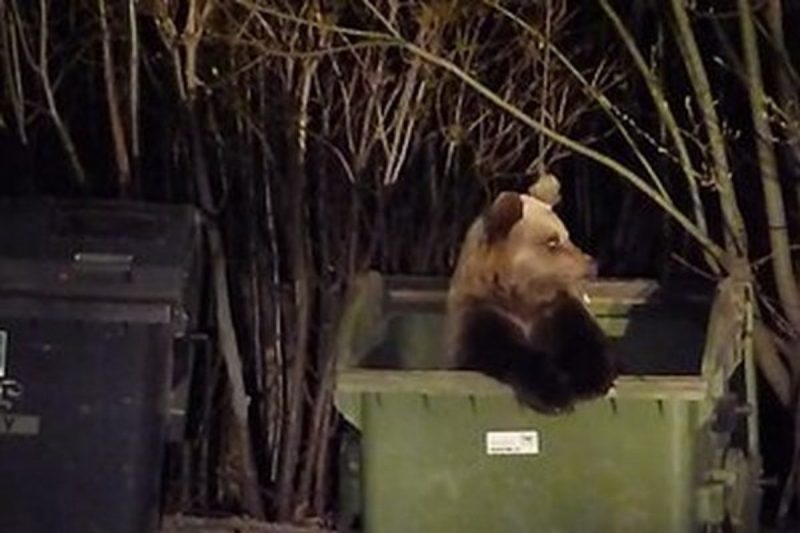Ako predísť konfliktom medzi človekom a medveďom
Medveď hnedý je najväčšia európska šelma, nekorunovaný kráľ našich lesov, ktorý sa najčastejšie vyskytuje vo Vysokých a Nízkych Tatrách, Malej a Veľkej Fatre a Muránskej planine. Podľa sčítania z roku 2015, na Slovensku žije 1240 medveďov, čo je podľa poľovníkov príliš veľa a podľa ochranárov málo. Počas sezóny dochádza k stretu turistov s medveďmi a návštevníci národných parkov reagujú požiadavkami na odstrel medveďov, v čom ich poľovníci a časť starostov a hotelierov horlivo podporuje. Náčelník mestskej polície mesta Vysoké Tatry Miroslav Kolodzej k tomu povedal: “Žiadali sme o dvadsať odstrelov, pretože sú premnožené, len na katastri nášho mesta ich je asi 130, ale povolili nám len dva, čo chodia do mestských častí najčastejšie“.
Prečo dochádza stále častejšie k návštevám ľudských sídiel a turistických zariadení medveďmi? Zuzana Kaliská zo Správy NAPANT-u hovorí, že najväčšie problémy s medveďmi sú tam, kde im to dovolíme. Najhoršie je to v lokalitách, kde si ľudia bezpečne neuzatvoria smeti. Pre medveďa je to najjednoduchší spôsob, ako sa dostať k potrave.
„Myslím si, že divokej zveri kradneme posledné kúsky priestoru. Zaberáme ich nielen výstavbou nových rekreačných stredísk, ale negatívny vplyv na teritórium medveďa má aj ťažba dreva. Najmä v hornej hranici lesa, ale aj v chránených oblastiach“.
Prirátajme k tomu masívny zber lesných plodín, ktoré sú prirodzenou potravou pre medvede, a je jasné, že medvede sú nútené k tomu, aby si vyhľadávali potravu v okolí dedín, hotelov, na poliach a salašoch, ktoré nie sú pred nimi dostatočne chránené.
Stále menšie prirodzené teritória si strážia najsilnejšie jedince a tie ostatné si hľadajú „teritóriá“ s najľahšie dostupnou potravou – s kontajnermi na odpadky. Tieto tzv. synantropné medvede sa ľahko dostávajú do konfliktov s človekom, čo posilňuje hlasy, volajúce po ich regulácii. Až 70% konfliktov s medveďom totiž zapríčiňuje nezabezpečený komunálny odpad. Medveď, ktorý si navykne na kontejner s potravinami, ktorý mu vyložíme pod nos, už nebude vyhľadávať potravu v prírode. Aj prikrmovanie medveďov poľovníkmi predstavuje neprirodzený zdroj potravy, na ktorý si ľahko zvykajú. Podobne ako pri iných živočíšnych druhoch, dostupnosť potravy určuje stav populácie, a tak dochádza k tomu, že samice vrhajú viac mláďat, ako je vo voľnej prírode obvyklé.
„Medvedí problém“ je v USA a Kanade pomerne uspokojivo vyriešený. V školách sa deti učia, že nesmú na záhradách nechávať jedlo, ktoré by medvede prilákalo. Kontajnery umiestňované v „medvedích“ regiónoch, ako aj na území národných parkov, sú konštruované tak, že medveď ich nedokáže otvoriť. Návštevníci národných parkov sú dôsledne upozorňovaní, aby nenechávali žiadne potraviny v stane, ale aby ich uložili do bezpečnostných skriniek, alebo ich vytiahli na lane do koruny stromu. Obyvatelia sú oboznámení s pravidlami, ako sa správať pri stretnutí s medveďom a v outdoorových obchodoch sa bežne dá kúpiť spray na obranu pred medveďom. Dodržiavanie týchto pravidiel výrazne znížilo počet konfliktov a to je vzor, z ktorého by sa malo poučiť aj Slovensko.
Našťastie, vďaka pomoci amerických ochranárov, minulý rok v obciach Štrba a Podkonice pribudli desiatky takýchto kontejnerov.
Strieľanie medveďov totiž neprichádza do úvahy a my sa musíme naučiť, ako s nimi spolunažívať. Medveď hnedý patrí medzi zákonom chránené živočíchy a o jeho výnimočnom odstrele rozhoduje ministerstvo životného prostredia, ktoré smie udeľovať povolenia.
Takže, ak pôjdete najbližšie do lesa, nenechávajte po sebe žiadne zvyšky jedla a riaďte sa radou znalcov: zaveste si na batoh zvonček alebo si počas chôdze pískajte a pospevujte, aby ste medveďa neprekvapili.
Location
Slovakia, Prešov Region, Poprad district, Vysoké Tatry
Environmental impact
- Biodiversity loss – Ecosystem destruction
- Alteration of landscape aesthetics and built heritage
Ethical/ legal issues
- A clean and prosperous environment and a safe and pleasant habitat
- Education and information
Information sources & materials
Online books and newspaper, magazine, encyclopedia, or blog articles
https://nasruzomberok.sme.sk/c/20532535/medvedom-kradneme-posledny-priestor.html
http://slobodazvierat.sk/Kontajnerove-medvede.71.0.html
http://www.vsetkyzvierata.estranky.sk/fotoalbum/cicavce/medved-hnedy/
http://www.wolf.sk/sk/medvede_konflikt_zaujmov
https://dennikn.sk/355857/konecne-vieme-kolko-mame-medvedov/
Contributor(s)
Štefan Szabó, Silvia Szabóová, SOSNA Association, Slovakia



Home › Forums › How to prevent conflicts between bear and human